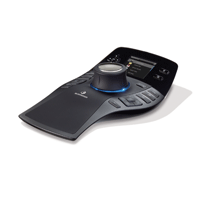Wh en I first saw this product's box on my desk, I felt like it was Christmas morning. Here's why.
en I first saw this product's box on my desk, I felt like it was Christmas morning. Here's why.
At a previous job, actually my third co-op while attending Northeastern University, one of the industrial designers in the company had one of 3Dconnexion's smaller, more basic 3D mice. Now I know it was the SpaceNavigator mouse. A black rotation knob encased in soft-touch rubber-like material that sat on a chrome-like silver circular body, with a constant soothing blue glow being dispersed underneath. What was this, 2035? Where had this come from? I always loved high-tech gadgets from a young age so I suddenly felt out of the loop.
I thought it was the coolest piece of technology, and was admittedly in awe of it. It looked like some sort of spaceship or alien disc. When I first noticed him using it, I was almost nervous to walk too close to his desk, fearing the thing would shoot something at me or say something to me, like Hal from 2001 Space Odyssey. This designer's desk was immediately behind mine, so I tended to sit and stare at it for a bit each day. He must have eventually gotten used to this.
This illusive creature didn't show up again on my radar until a bit later. I've been to several CAD software rollout seminars over the years and at the more recent ones, they had these bad boys out on display for test drives. I was usually one of the first people to unabashedly sit and give them a shot because I think they are things of beauty. I always dreamed of getting my hands on one for a couple hours, if not owning one. This was the first time I saw some of Connexion's larger, more complex 3D mice. These were amazing specimens, comprising the same basic rotation knob as the SpaceNavigator, but surrounded by a zip code of buttons, sometimes a small LCD screen. Amazing.
About a year and a half later. Two months deep as an applications engineer at KubotekUSA, Inc. The white shoebox-size 3D Connexion box awaited me beside my laptop. I eagerly opened the box, and immediately took everything out and peeled all protective wrappers off the product (which my father always said should never be removed from ANYTHING you've just purchased. My parents purchased and installed a new dishwasher about two years ago, and I think the bright blue commercial protective plastic wrap still covers the front. A white dishwasher. Blue wrap. Please.)
 I looked at this new SpacePilot Pro mouse. I felt like someone had just given me a new car. I sent a close friend (a non-engineer who had never heard of a 3D mouse) a picture of my new toy. He responded saying he was seriously intimidated by the thing, and that it looked like after it would make him coffee, it would proceed to read his mind.
I looked at this new SpacePilot Pro mouse. I felt like someone had just given me a new car. I sent a close friend (a non-engineer who had never heard of a 3D mouse) a picture of my new toy. He responded saying he was seriously intimidated by the thing, and that it looked like after it would make him coffee, it would proceed to read his mind.
About 9" in full length, the base of this charcoal and black-hued mouse is shaped like an undulating wave, very ergonomic for hand and wrist placement. A thick strip of a soft-touch gripper area cuts down the middle of the mouse so your hand and wrist don't slide around while in use. The rotation knob lies in the center, above which is an LCD screen similar in size to that of the common digital camera. The LCD screen displays the customizable functions attached to the plethora of buttons on the mouse's, what I like to call, ‘dashboard'. In addition to this, the screen also displays Outlook emails, opens up web browsers on your computer screen, opens and controls your computer's music player, and I could go on.
I really appreciate that with a barely perceptible flick of the finger or wrist I can quickly execute both menial and complex tasks in KeyCreator, when using the SpacePilot Pro mouse. This thing has 31 programmable/customizable buttons, to be exact. I have programmed every single one (which, incidentally, was easy).
Some of the mouse button functions that I have customized to be most easily selectable (because they are larger, or because of their location) are Delete Multiple Entities, Escape, Delete Dimensions, Direct Dimensional Edit, Construction Planes, Undo and finally... Autoscale. I am addicted to this function. I've programmed it to a button larger than the others that is set apart from the rest. Some of these buttons will soon be super smooth and label-less due to abuse.
Utilizing a 3D mouse with programmable buttons does, indeed, decrease the time it takes to build a model in KeyCreator. I can plow through tasks with lightening speed, without even thinking about it. My fingers have trained themselves to remember when to shoot over to which buttons to do which tasks. It was like learning an interesting unilateral version of touch-typing. Admittedly, it took some practice and getting used to, remembering what buttons were programmed to do what; however, once I reached a comfort level, my speed quickly increased. This mouse omits the necessity of excess mouse travel with your right hand, excess hand travel of your land hand (i.e. selecting Esc, Shift, Ctrl, Spacebar etc), and thus reduces design time. Amazing multitask tool.
Before I had the SpacePilot Pro, I had the more basic SpaceNavigator orb model. Although it lacks all those programmable buttons, it still significantly decreases mouse travel and design time. It's also very portable due to its size, and perfect for tradeshows and quick demos. After manning a booth at two tradeshows while using both of these models for demos, I can say they attract some attention. Show attendees would walk up saying, ‘What on earth is that?' The combination of demonstrating KeyCreator in conjunction with these 3D mice has been enjoyable. It augments the capabilities of our CAD software, making it more powerful.
There is no ‘honeymoon period' with the SpacePilot Pro mouse. This will be perpetually beneficial. I cannot wait to see what 3Dconnexion comes up with next, because it will likely further augment the CAD software industry.
If you are interested in buying a SpacePilot Pro, check it out on Amazon: 3Dconnexion SpacePilot PRO - 3D motion controller - 31 button(s) - wired - USB
